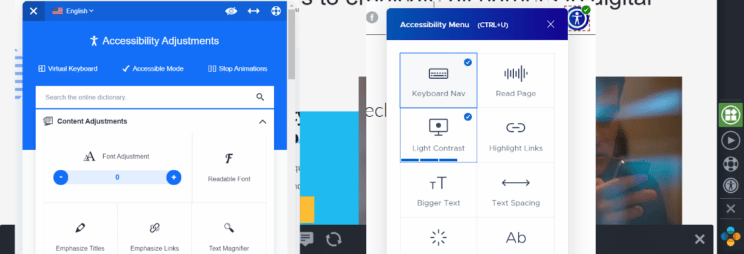What Is An Overlay Tool?
Accessibility overlays, toolbars, and plugins are third-party widgets that attempt to automatically improve the accessibility of websites they are added to. They may provide additional functionality such as text resizing, element highlighting, and color scheme adjustments through a custom “popup” interface, all aimed at making your website easier to use. But most of the functionality does not move the needle too far if you’re attempting to conform to either WCAG 2.0 or 2.1 requirements.

As it turns out, nearly all of the functionality provided by these tools has no impact on your level of WCAG conformance whatsoever. Furthermore, these overlays provide little or no additional legal protection for your website. In fact, in recent lawsuit filings, screenshots of these tools are being used to build the claim against websites that are not also seeking a holistic approach to ADA compliance. It is also a common belief that these tools may increase your security risks, and many companies’ security policies prohibit the installation of widgets like these.
Separate Experiences for Groups of Users… is that advised?
Overlay tools are activated by the user. When activated, the page is changed in ways you may not even realize or understand if you are not a native user of assistive technology tools. Worse, the overlay provides a sub-par experience for users damaging your brand in the meantime. Furthermore, this separate and subpar experience likely does not decrease your risk for some type of legal action.
Create Great Experiences, Not Band-Aids
When it comes to accessibility, Allyant’s Ryan Wieland often says in legal training classes that “Your best defense is a good offense.” No tool will ever beat the effectiveness of empathic designers, developers, and content creators who make digital equity a central tenet of their workflow.
Therefore, rather than spending time and money focusing on external fixes for internal problems, use those same resources to empower your team through continuous education and innovative, universal design and development practices. Not only will you end up with a website that meets the needs of everyone who uses it, but you will also be investing in your own team and helping them implement a sustainable process for maintaining accessible websites.
Equitable Access Done The Right Way
In summary, accessibility overlays should never be considered as a viable permanent solution for website accessibility issues. At best, they can only address a very small set of accessibility requirements and most often do so imperfectly. Find out how a cost-effective, live-user audit & remediation support plan by Accessible360 can help your organization.

